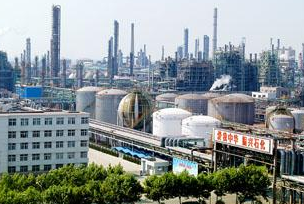The source and prevention of chemical pollution
(2) Both biological oxygen demand (BOD) and chemical oxygen demand (COD) are higher
Chemical wastewater, especially petrochemical production wastewater, contains a variety of organic acids, alcohols, aldehydes, ketones, ethers and epoxides, which are characterized by high biochemical and chemical oxygen demand. Some as high as tens of thousands of milligrams per liter. Once this waste water is discharged into the water body, it will be further oxidized and hydrolyzed in the water, thus consuming a large amount of dissolved oxygen in the water, and directly threatening the survival of aquatic organisms.

(3) pH is unstable
The wastewater discharged from chemical production is sometimes strongly acidic and sometimes strongly alkaline, and the pH is very unstable, which has great harm to aquatic organisms, structures and crops.
(4) More nutritive substances
Some of the chemical production wastewater contains too much phosphorus and nitrogen, resulting in eutrophication in the waters, causing algae and microorganisms to proliferate in the water, and in serious cases, forming a "red tide", causing fish to suffocate and die in large numbers.
(5) High wastewater temperature
Because the chemical reaction is often carried out at high temperatures, the water temperature of the discharged wastewater is higher. After this high temperature water is discharged into the water, it will cause thermal pollution of the water body, reduce the dissolved oxygen in the water, and destroy the living conditions of aquatic organisms. Thermal pollution will affect the fishery production, on the one hand, the increase of water temperature can reduce the dissolved oxygen in the water, on the other hand, it will increase the metabolic rate of fish and require more dissolved oxygen, and the development of fish under the action of thermal stress is hindered, and even die.
(6) Oil pollution is more common
Petrochemical wastewater generally contains oil, which not only endangers the survival of aquatic organisms, but also increases the complexity of wastewater treatment.
(7) Recovery is difficult
Even if the water polluted by chemical harmful substances is reduced or stopped, it will still take a long time to return to the raw material state of the water, especially for heavy metal pollutants that can be enriched by organisms, and it is still difficult to eliminate the pollution state after stopping the discharge.
Ways of prevention and control
To prevent and control chemical pollution effectively, we should consider two aspects. One is to reduce emissions; Second, we will strengthen governance. Management includes the proper treatment, recycling and utilization of waste.
Control tool
In the process of recycling waste liquid, leakage and rollover events will inevitably occur, and waste liquid will flow out, causing re-pollution. In this regard, anti-leakage tray came into being. Anti-leakage tray, also known as leakage tray, anti-spill tray, anti-spill tray, anti-spill tray, oil drum tray, anti-leak tray, oil tray tray, oil tray, is a polyethylene material container designed and developed to prevent and control the leakage of oil drums and chemical drums and other oil and chemical containers used in modern factories, warehousing, logistics, transportation industry. It is mainly used for chemical packaging and storage, which can prevent environmental pollution and protect personal safety.
Bikon Industries is committed to providing solutions for the production and processing of rotomized containers. Committed to providing automation and information products and services for water treatment dosing equipment; It is committed to preventing the leakage of oil hazardous chemicals and improving the safety protection level of industrial production.
- EMERSON
- Honeywell
- CTI
- Rolls-Royce
- General Electric
- Woodward
- Yaskawa
- xYCOM
- Motorola
- Siemens
- Rockwell
- ABB
- B&R
- HIMA
- Construction site
- electricity
- Automobile market
- PLC
- DCS
- Motor drivers
- VSD
- Implications
- cement
- CO2
- CEM
- methane
- Artificial intelligence
- Titanic
- Solar energy
- Hydrogen fuel cell
- Hydrogen and fuel cells
- Hydrogen and oxygen fuel cells
- tyre
- Chemical fiber
- dynamo
- corpuscle
- Pulp and paper
- printing
- fossil
- FANUC
- Food and beverage
- Life science
- Sewage treatment
- Personal care
- electricity
- boats
- infrastructure
- Automobile industry
- metallurgy
- Nuclear power generation
- Geothermal power generation
- Water and wastewater
- Infrastructure construction
- Mine hazard
- steel
- papermaking
- Natural gas industry
- Infrastructure construction
- Power and energy
- Rubber and plastic
- Renewable energy
- pharmacy
- mining
- Plastic industry
- Schneider
- Kongsberg
- NI
- Wind energy
- International petroleum
- International new energy network
- gas
- WATLOW
- ProSoft
- SEW
- wind
- ADVANCED
- Reliance
- YOKOGAWA
- TRICONEX
- FOXBORO
- METSO
- MAN
- Advantest
- ADVANCED
- ALSTOM
- Control Wave
- AB
- AMAT
- STUDER
- KONGSBERG
- MOTOROLA
- DANAHER MOTION
- Bently
- Galil
- EATON
- MOLEX
- Triconex
- DEIF
- B&W
- ZYGO
- Aerotech
- DANFOSS
- KOLLMORGEN
- Beijer
- Endress+Hauser
- MOOG
- KB
- Moxa
- Rexroth
- YAMAHA
- Johnson
- Westinghouse
- WAGO
- TOSHIBA
- TEKTRONIX


Email:wang@kongjiangauto.com



































































































































